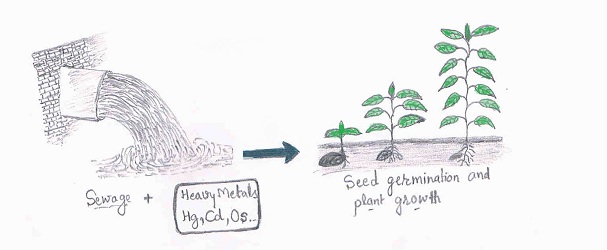
Effect of heavy metals and sewage on seed germination and plant growth
Abstract
In present study Pea, Pigeon pea were taken as experimental plant in order to study effect of sewage irrigation on germination and growth of plants. Deleterious effect of heavy metal on seed germination, protein, sugars, hydrolytic enzyme activities were studied. Concentrated sewage and higher concentration of heavy metal produce adverse effect on germination, alongwith other parameters i.e. protein, sugar and enzyme activity. Maximum deleterious effect was in 100% sewage concentration and 3-5 mM of heavy metals. The field work was conducted and it was found that heavy metals are present in sewage effluent, mostly in prescribed limit with few crossing the limits. With continuous irrigation, metals get accumulated on the soil with decreasing amount with the depth. The crops grown on such lands and irrigated with sewage effluent, showed higher plant growth but most of the parts of plant were found to be containing heavy metals in higher amount compared to the plants grown on tube well irrigated fields. It is predictive that with continuous exposure and irrigation the amount of heavy metal would keep on increasing in plant and thus would affect the food chain mainly the humans.
Keywords
References
I. Shigematsu. The epidemiological approach to cadmium pollution in Japan. Ann Acad Med Singapore 1984, 13, 231-6.
K. Nogawa, T. Kido. Biological monitoring of cadmium exposure in itai-itai disease epidemiology. Int Arch Occup Environ Health 1993, 65, S43-6.
M. Yamaguchi, A. Yasutake, M. Nagano, Y. Yasuda. Accumulation and distribution of methylmercury in freshwater- and seawater-adapted eels. Bull Environ Contam Toxicol 2004, 73, 257-63.
K.S. Dhillon, S.K. Dhillon, N. Pareek. Distribution and bioavailability of selenium fractions in some seleniferous soils of Punjab, India. Archives of Agronomy and Soil Science 2005, 51, 633-43.
N. Rani, K.S. Dhillon, S.K. Dhillon. Critical Levels of Selenium in Different Crops Grown in an Alkaline Silty Loam Soil Treated with Selenite-Se. Plant Soil 2005, 277, 367-74.
M.A. Oliver. Soil and human health: a review. European Journal of Soil Science 1997, 48, 573-92.
A.P. Gupta, R.P. Narwal, R.S. Antil. Sewer water composition and its effect on soil properties. Bioresource Technology 1998, 65, 171-73.
W.L. Lindsay, W.A. Norvell. Development of a DTPA Soil Test for Zinc, Iron, Manganese, and Copper. Soil Sci. Soc. Am. J. 1978, 42, 421-28.
J.J. Wang, D.L. Harrell, R.E. Henderson, P.F. Bell. Comparison of Soil-Test Extractants for Phosphorus, Potassium, Calcium, Magnesium, Sodium, Zinc, Copper, Manganese, and Iron in Louisiana Soils. Communications in Soil Science and Plant Analysis 2004, 35, 145-60.
K.E. Giller, E. Witter, S.P. McGrath. Toxicity of heavy metals to microorganisms and microbial processes in agricultural soils: a review. Soil Biology and Biochemistry 1998, 30, 1389-414.
P. Nosko, P. Brassard, J.R. Kramer, K.A. Kershaw. The effect of aluminum on seed germination and early seedling establishment, growth, and respiration of white spruce (Picea glauca). Canadian journal of botany 1988, 66, 2305-10.
M. Patra, A. Sharma. Mercury toxicity in plants. Bot. Rev 2000, 66, 379-422.
A. Mishra, M.A. Choudhuri. Monitoring of Phytotoxicity of Lead and Mercury from Germination and Early Seedling Growth Indices in Two Rice Cultivars. Water, Air, & Soil Pollution 1999, 114, 339-46.
L.K. Chugh, S.K. Sawhney. Effect of cadmium on germination, amylases and rate of respiration of germinating pea seeds. Environ Pollut 1996, 92, 1-5.
P. Bansal, P. Sharma, V. Goyal. Impact of Lead and Cadmium on Enzyme of Citric Acid Cycle in Germinating Pea Seeds. Biologia Plantarum 2002, 45, 125-27.
S. McGrath, A. Chaudri, K. Giller. Long-term effects of metals in sewage sludge on soils, microorganisms and plants. Journal of Industrial Microbiology 1995, 14, 94-104.
S. Adhikari, S.K. Gupta. Assessment of the quality of sewage effluents from dry weather flow channel, Calcutta. Indian journal of environmental health 2002, 44, 197-202.
E. Gajewska, M. Skłodowska, M. Słaba, J. Mazur. Effect of nickel on antioxidative enzyme activities, proline and chlorophyll contents in wheat shoots. Biologia Plantarum 2006, 50, 653-59.
M.L. Kashyap, B.A. Hynd, K. Robinson. A rapid and simple method for measurement of total protein in very low density lipoproteins by the Lowry assay. J Lipid Res 1980, 21, 491-5.
H. Yomo, J.E. Varner. Control of the formation of amylases and proteases in the cotyledons of germinating peas. Plant Physiol 1973, 51, 708-13.
L. Beevers. Protein degradation and proteolytic activity in the cotyledons of germinating pea seeds (pisum sativum). Phytochemistry 1968, 7, 1837-44.
B. Sieliwanowicz. Polyadenylation of pea seed RNA at the early stages of germination. Acta Biochim Pol 1978, 25, 239-45.
P. Stewart, D. Pitt. Ultrastructural localization of acid phosphatase activity in root tips by the p-(acetoxymercuric) aniline diazotate reagent and a comparison with a Gomori procedure. J Cell Sci 1977, 26, 19-29.
E. Epstein, J.M. Taylor, R.L. Chancy. Effects of Sewage Sludge and Sludge Compost Applied to Soil on some Soil Physical and Chemical Properties1. J. Environ. Qual. 1976, 5, 422-26.
ISSN 2347 – 8853
Indexed in:
 ISSN 2347 – 8853
ISSN 2347 – 8853  Â
Â